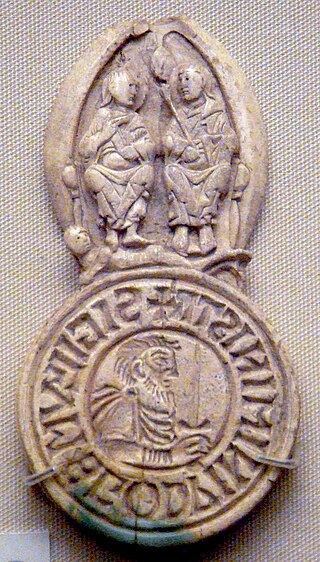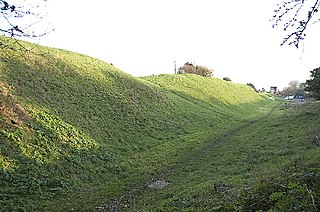Related Research Articles

In Anglo-Saxon England, thegns were aristocratic landowners of the second rank, below the ealdormen who governed large areas of England. The term was also used in early medieval Scandinavia for a class of retainers. In medieval Scotland, there were local officials known as thanes.
A hundred is an administrative division that is geographically part of a larger region. It was formerly used in England, Wales, some parts of the United States, Denmark, Southern Schleswig, Sweden, Finland, Norway, the Bishopric of Ösel–Wiek, Curonia, the Ukrainian state of the Cossack Hetmanate and in Cumberland County in the British Colony of New South Wales. It is still used in other places, including in Australia.
The term soke, at the time of the Norman conquest of England, generally denoted "jurisdiction", but its vague usage makes it probably lack a single, precise definition.

Lord of the Manor is a title that, in Anglo-Saxon England, referred to the landholder of a rural estate. The lord enjoyed manorial rights as well as seignory, the right to grant or draw benefit from the estate. The title continues in modern England and Wales as a legally recognised form of property that can be held independently of its historical rights. It may belong entirely to one person or be a moiety shared with other people.

England in the Middle Ages concerns the history of England during the medieval period, from the end of the 5th century through to the start of the Early Modern period in 1485. When England emerged from the collapse of the Roman Empire, the economy was in tatters and many of the towns abandoned. After several centuries of Germanic immigration, new identities and cultures began to emerge, developing into kingdoms that competed for power. A rich artistic culture flourished under the Anglo-Saxons, producing epic poems such as Beowulf and sophisticated metalwork. The Anglo-Saxons converted to Christianity in the 7th century and a network of monasteries and convents were built across England. In the 8th and 9th centuries England faced fierce Viking attacks, and the fighting lasted for many decades, eventually establishing Wessex as the most powerful kingdom and promoting the growth of an English identity. Despite repeated crises of succession and a Danish seizure of power at the start of the 11th century, it can also be argued that by the 1060s England was a powerful, centralised state with a strong military and successful economy.

Anglo-Saxon law is a body of written rules and customs that were in place during the Anglo-Saxon period in England, before the Norman conquest. This body of law, along with early Medieval Scandinavian law and Germanic law, descended from a family of ancient Germanic custom and legal thought. However, Anglo-Saxon law codes are distinct from other early Germanic legal statements—known as the leges barbarorum, in part because they were written in Old English instead of in Latin. The laws of the Anglo-Saxons were the second in medieval Western Europe after those of the Irish to be expressed in a language other than Latin.
The court leet was a historical court baron of England and Wales and Ireland that exercised the "view of frankpledge" and its attendant police jurisdiction, which was normally restricted to the hundred courts.

In Anglo-Saxon England, the reeve was a senior official with local responsibilities under the Crown, such as the chief magistrate of a town or district. After the Norman conquest, it was an office held by a man of lower rank, appointed as manager of a manor and overseer of the peasants. In this later role, historian H. R. Loyn observes, "he is the earliest English specialist in estate management."
The term Middle English literature refers to the literature written in the form of the English language known as Middle English, from the late 12th century until the 1470s. During this time the Chancery Standard, a form of London-based English became widespread and the printing press regularized the language. Between the 1470s and the middle of the following century there was a transition to early Modern English. In literary terms, the characteristics of the literary works written did not change radically until the effects of the Renaissance and Reformed Christianity became more apparent in the reign of King Henry VIII. There are three main categories of Middle English literature, religious, courtly love, and Arthurian, though much of Geoffrey Chaucer's work stands outside these. Among the many religious works are those in the Katherine Group and the writings of Julian of Norwich and Richard Rolle.
The tourn was the bi-annual inspection of the hundreds of his shire made by the sheriff in medieval England. During it he would preside over the especially full meetings of the hundred court which met during the tourn at Easter and Michaelmas.
Vill is a term used in English history to describe the basic rural land unit, roughly comparable to that of a parish, manor, village or tithing.
A tithing or tything was a historic English legal, administrative or territorial unit, originally ten hides. Tithings later came to be seen as subdivisions of a manor or civil parish. The tithing's leader or spokesman was known as a tithingman.
In English law, the term headborough, head-borough, borough-head, borrowhead, or chief pledge, referred historically to the head of the legal, administrative, and territorial unit known as a tithing, which sometimes, particularly in Kent, Surrey and Sussex, was known as a borgh, borow, or borough. The office was rendered in Latin documents as capitalis plegius or decennarius (tenner).

The manorial courts were the lowest courts of law in England during the feudal period. They had a civil jurisdiction limited both in subject matter and geography. They dealt with matters over which the lord of the manor had jurisdiction, primarily torts, local contracts and land tenure, and their powers only extended to those who lived within the lands of the manor: the demesne and such lands as the lord had enfeoffed to others, and to those who held land therein. Historians have divided manorial courts into those that were primarily seignorial – based on feudal responsibilities – and those based on separate delegation of authority from the monarch. There were three types of manorial court: the court of the honour; the court baron; and the court customary, also known as the halmote court.

The ancient boroughs were a historic unit of lower-tier local government in England and Wales. The ancient boroughs covered only important towns and were established by charters granted at different times by the monarchy. Their history is largely concerned with the origin of such towns and how they gained the right of self-government. Ancient boroughs were reformed by the Municipal Corporations Act 1835, which introduced directly elected corporations and allowed the incorporation of new industrial towns. Municipal boroughs ceased to be used for the purposes of local government in 1974, with borough status retained as an honorific title granted by the Crown.
A parish constable, also known as a petty constable, was a law enforcement officer, usually unpaid and part-time, serving a parish. The position evolved from the ancient chief pledge of a tithing, and takes its name from the office of constable, with which it was originally unconnected.
Whorwellsdown was a hundred of the English county of Wiltshire, lying in the west of the county to the south of the towns of Bradford on Avon and Melksham and to the north and east of Westbury. An arm of the hundred reached several miles southwards into Salisbury Plain, with a detached portion, a tithing of Tilshead, lying high on the Plain about five miles east of the southern arm of the rest of the hundred. At its western end, it reached as far as the Somerset county boundary.

The medieval English saw their economy as comprising three groups – the clergy, who prayed; the knights, who fought; and the peasants, who worked the landtowns involved in international trade. Over the five centuries of the Middle Ages, the English economy would at first grow and then suffer an acute crisis, resulting in significant political and economic change. Despite economic dislocation in urban and extraction economies, including shifts in the holders of wealth and the location of these economies, the economic output of towns and mines developed and intensified over the period. By the end of the period, England had a weak government, by later standards, overseeing an economy dominated by rented farms controlled by gentry, and a thriving community of indigenous English merchants and corporations.
Guildable Manor is a Court Leet in Southwark under the authority of the City of London, along with the King's Manor, Southwark, and the Great Liberty. The name of 'Guildable' first recorded in 1377 refers to the collection of taxes there and was adopted to distinguish this from the other manors of the Southwark area. Its legal title, according to a Royal charter granted to the City by King Edward III in 1327, is 'the ville of Southwark' i.e. 'ville = 'town'; in the more substantive charter of Edward VI it is designated 'The Town and Borough of Southwark' as is stated on its Seal. It is a preserved limited jurisdiction under the Administration of Justice Act 1977. Although neither a guild nor a livery company, the Guildable Manor does have a permanent organization, consisting of Officers and Jurors.

The History of the Norman Conquest of England: Its Causes and Its Results is a six-volume study of the Conquest by Edward A. Freeman, published between 1867 and 1879. Recognised by critics as a major work of scholarship on its first publication, it has since proved unpopular with readers, many of whom were put off by its enormous length and copious detail. Academics have often criticized it for its heavily Whig treatment of the subject, and its glorification of Anglo-Saxon political and social institutions at the expense of their feudal successors, but its influence has nevertheless been profound, many Anglo-Norman historians of modern times having come around to some of Freeman's main conclusions.
References
- Chisholm, Hugh, ed. (1911). . Encyclopædia Britannica . Vol. 11 (11th ed.). Cambridge University Press. pp. 34–35.
- Olson, Trisha. "Frankpledge", The Catholic University of America - Columbus School of Law
- Morgan, C. Lloyd (1885). The Springs of Conduct. London: Kegan Paul.
- Pearson, Charles Henry (1867). History of England During the Middle Ages, Vol. I. London: Bell and Daldy.
- Pollard, Albert F. (1912). The History of England: A Study in Political Evolution. London: Williams and Norgate.
- Smith, Toulmin (1857). The Parish: Its Powers and Obligations at Law. London: H. Sweet.
- Stubbs, William (1906). Lectures on Early English History. London: Longmans, Green, and Co.
- Thorpe, Benjamin (1845). A History of England under the Anglo-Saxon Kings, Vol. II. London: John Murray.
- White, Archer M. (1895). Outlines of Legal History. London: Swan Sonneschein & Co.